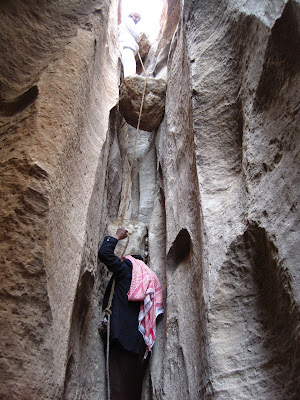A week into the Egypt leg of my Watson adventure, I feel stupid for not coming sooner. As beautiful as Jordan is as a country, Amman just doesn't compare to Cairo by any measure.
After a few days bumming around Cairo as a tourist, devouring bowls of koshari, taking 'oud lessons, and exploring the souqs and alleys of my neighborhood, I made my first monastery visit.
To get permission to do this, I went to the Coptic Cathedral, where they promptly rejected me, sending me to the monastery offices at another church. In classic Egyptian bureaucratic fashion, the priest at this church said I needed to get a letter from the cathedral before he could issue a permission. Oy vey.
I used the only weapon at my disposal - looking pathetic and sad, and a Coptic guy drove me to the cathedral and vouched for me to some Abba, who was very skeptical of the intentions of a Catholic, a LATIN Catholic. (sidenote: isn't it funny how you can often tell prejudices from grammar and pronunciation? Eye-rakki, eye-talian, using Jew as an adjective, and pronouncing a hard o in Cath-o-lic. Anyways...) After some begging and ring-kissing (yeah, that happened), I got the letter allowing me to visit Deir Anba Bishoi and stay for a few days with the monks.
Arriving in Wadi Natrun the next day, the monk at the gate told me that while I could visit the monastery, due to the fast for advent, visitors were only allowed to stay in the papal palace at the monastery.
"Does your letter of introduction say that you can stay there?" the monk asked.
"Sure," I replied, having not read the letter (Arabic hand-written by old people is really hard to read).
Well, upon further examination, I wasn't allowed anywhere near the papal anything. Nice try. I went into the old church and got my first taste of Coptic prayers. In a hall thick with incense, the monks chanted, playing tambourines and cymbals as pilgrims came in to touch and pray before the relics of St. Bishoi.
On my way out, I stopped briefly at the Well of Martyrs, where the Bedouins who massacred the monks in the Middle Ages washed their swords.
With no clear idea of where I would sleep that night, I decided to try Deir al-Baramous, another of the Wadi Natrun monasteries that thanks to a lovely old Coptic abuna in St. Louis, I have a letter of introduction to.
After some intense questioning by a couple of monks, they decided that an Americani Katholiki could stay there for a few days.
Now I'm just going to come right out and say it: monastic life sucks. I like reading about monasteries and their histories, the works that get produced in them and even ecclesiastical politics. But I usually do those sorts of nerdy things within a normal schedule of eating and sleeping. That wasn't to be found.
The first evenings prayers were interesting enough, trying to follow along in Arabic and Greek to understand what was happening in Coptic kept me going despite my stomach growls. After reading most of the Sayings of the Desert Fathers (I have a post coming on St. Moses the Black, who had a great sense of humor), I went to sleep hungry. I had missed the one meal of the day.
I didn't get much sleep on the mostly wooden bed and pillow that seemed especially ascetic. That wouldn't matter much as I was awoken at 3am for the next set of prayers. Expecting another hour-long episode of chanting. I was dismayed to find that I was still standing in a smokey church four hours later. They had kicked us pilgrims out before communion. So I couldn't even get some bread for my trouble.
My fellow pilgrims read the Bible and saints' lives in our room. Now I don't believe in God under normal circumstances, and I especially don't believe in Him having not eaten in about 36 hours or slept more than three. I took a nap.
I woke up at noon when a pilgrim asked me if I wanted to eat. Okay, God and I are back on good terms. The meal was bread and fool, mashed fava beans. My friend Andrew once remarked that even good fool tastes a little bit like vomit. This was really bad fool. Nevertheless, I demolished a plate of it. There was a saucer of molasses that I just started taking licks of, Bear Dinner-style.
Back to normal, I spent the afternoon reading more about the Desert Fathers, including St. Macarius, who founded al-Baramous, and St. Moses the Black, who is buried there. I alternated between thinking, "these are some alright dudes" and "wow, that's kinda messed up." Asceticism isn't my cup of tea. I think today these behaviors are termed anorexia and self-harm. Or at least being really emo for God. But I digress.
More prayers and less sleep, and it was finally the next day. I declined the invitation of my novice host (who was a great guy and wore a baby-blue dishdash) to stay another few days, and I headed back to Cairo, a city where I can buy a baked sweet potato on the street at midnight for 50 cents. In other words, home.
[A note on the name Deir al-Baramous: Deir means monastery, so that's self-explanatory. Despite being better known for Moses the Black, Baramous takes its Coptic name Pi-Romios from two Roman brothers, sons of the emperor who came to the desert to meet Macarius and then proceeded to fast themselves to death. Smart.]
Location:Cairo, Egypt










